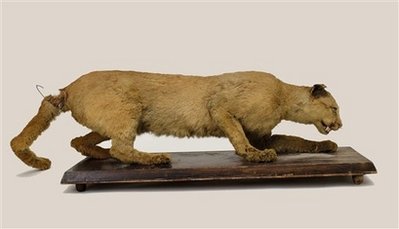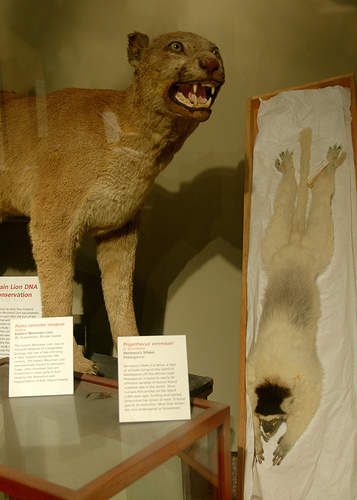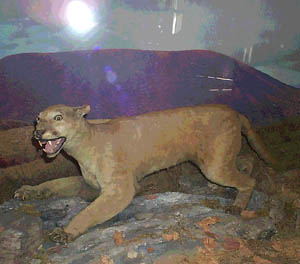The Eastern Panther Is Extinct, Say Feds! What Are The Politics Behind Their Declaration?
Posted by: Loren Coleman on March 3rd, 2011

The declarations from the United States government are rather clear. In summary, on March 2, 2011, the U.S. Fish and Wildlife Service, in essence and reality, told the people of the United States the following:
Your sightings of the Eastern subspecies of the mountain lion (Puma concolor couguar) have been dismissed.
Your investigations of the existence of the Eastern panther (Puma concolor couguar) have been a waste of your time.
Your findings of footprints and other solid evidence of the Eastern cougar (Puma concolor couguar) are incorrect.
On Wednesday, the United States Fish and Wildlife Service “declared the eastern cougar to be extinct, confirming a widely held belief among wildlife biologists that native populations of the big cat were wiped out by man a century ago. After a lengthy review, federal officials concluded there are no breeding populations of cougars — also known as pumas, panthers, mountain lions and catamounts — in the eastern United States. Researchers believe the eastern cougar subspecies has probably been extinct since the 1930s,” reported Michael Rubinkam for the Associated Press. “Wednesday’s declaration paves the way for the eastern cougar to be removed from the endangered species list, where it was placed in 1973.”
“During the review, the Service received 573 responses to a request for scientific information about the possible existence of the eastern cougar subspecies; conducted an extensive review of U.S. and Canadian scientific literature; and requested information from the 21 States within the historical range of the subspecies,” noted the U.S. Fish and Wildlife Service.

This is said to be the last Eastern cougar to have existed in Pennsylvania; it was killed in Pennsylvania in 1874 by Thomas Anson. The felid was formerly part of the collection of Henry Shoemaker. Photo: State Museum of Pennsylvania, Pennsylvania Historical and Museum Commission, 2006.
The government’s findings does not effect the Florida panther, which is considered to be another subspecies (Puma concolor coryi). Though the Florida panther once ranged throughout the Southeast, it now exists in less than five percent of its historic habitat and in only one breeding population of 120 to 160 animals in southwestern Florida.
The wildlife service confirmed 108 sightings of supposed Eastern panthers (Puma concolor couguar) between 1900 and 2010, but noted that these animals, they said, were not Puma concolor couguar but instead were “either escaped or were released from captivity, or migrated from western states to the Midwest.”
The exact wording of the government news release stated: “Reports of [Eastern] cougars observed in the wild examined during the review process described cougars of other subspecies, often South American subspecies, that had been held in captivity and had escaped or been released to the wild, as well as wild cougars of the western United States subspecies that had migrated eastward to the Midwest.”

Eastern mountain lion, Harvard Museum of Natural History, Boston, Massachusetts. Photo: Curious Expedition, 2009.
Mark McCollough, an endangered species biologist who led the agency’s eastern cougar study, said that the last wild Eastern cougar was believed to have been killed in Maine in 1938.
Case closed? It appears the government wants us to think as much. They want you to stop all actions to prove there are any populations left in the East. They wish to have the debate ended.
No more “spotted owl syndrome” worries for developers and forest owners out East? No more funding needs for Eastern panther research?
Or is there something more deeply going on?
What might be the next focus of the government if they tell us that such and such species are no longer there?
We have to look no further than some recent historical information.
The politics of this declaration clearly pitted the 5-year-old private, well-funded, government-linked Eastern Cougar Foundation, recently renamed the Cougar Rewilding Foundation, against the 42-year-old grassroots, poorly-funded, nongovernmental Eastern Puma Research Network. The shift in focus of the ECF to reintroducing mountain lions into their alleged former ranges in the East vs the EPRN’s desire to provide proof of the still-established Eastern panther may foreshadow a policy of the U.S. Fish and Wildlife Service.
All future sightings of large, tan, deer-colored felids in the Eastern USA now will again exist in that shadowy zoological limbo occupied by the Ivory-billed woodpecker and Bigfoot. The Eastern panther has regained firm footing, anew, as a full-fledged cryptid. But it won’t matter, if mountain lions are reintroduced into the old ranges, and the picture gets messy and confusing, now will it?

Eastern panther as a museum specimen, this one from Pennsylvania, and the original Nittany Lion, apparently or probably not. Photo: Dave Bonta, apparently.
About Loren Coleman
Loren Coleman is one of the world’s leading cryptozoologists, some say “the” leading living cryptozoologist. Certainly, he is acknowledged as the current living American researcher and writer who has most popularized cryptozoology in the late 20th and early 21st centuries.
Starting his fieldwork and investigations in 1960, after traveling and trekking extensively in pursuit of cryptozoological mysteries, Coleman began writing to share his experiences in 1969. An honorary member of Ivan T. Sanderson’s Society for the Investigation of the Unexplained in the 1970s, Coleman has been bestowed with similar honorary memberships of the North Idaho College Cryptozoology Club in 1983, and in subsequent years, that of the British Columbia Scientific Cryptozoology Club, CryptoSafari International, and other international organizations. He was also a Life Member and Benefactor of the International Society of Cryptozoology (now-defunct).
Loren Coleman’s daily blog, as a member of the Cryptomundo Team, served as an ongoing avenue of communication for the ever-growing body of cryptozoo news from 2005 through 2013. He returned as an infrequent contributor beginning Halloween week of 2015.
Coleman is the founder in 2003, and current director of the International Cryptozoology Museum in Portland, Maine.










Loren wrote, “All future sightings of large, tan, deer-colored felids in the Eastern USA now will again exist in that shadowy zoological limbo occupied by the Ivory-billed woodpecker and Bigfoot.”
Well, not exactly. This case is different because the FWS is not declaring all sightings invalid. They are saying that validated sightings are of cougars from sources other than the original Eastern subspecies stock.
Of course, a fair question is, “If a sighting is valid but the cat is not caught, how can anyone be sure where said cat came from?”
The FWS answer is essentially that breeding populations would have left more evidence than we now have. That brings up a couple of complications. One is that the cat is notoriously elusive, and I wonder just how sure the FWS can be. The other, as someone pointed out on Facebook, is that it may not matter: if escaped, released, or wandering cougars establish a population, then you still have a population of a protected animal and must regulate it (although you don’t have a population of an ENDANGERED animal, which is where politics come in since the latter must be protected and regulated much more extensively.)
The politics do exist. I’ve reported before how a friend of mine, an excellent witness who knew his bears, reported literally bumping into an unmistakable grizzly bear in Colorado and was told very frankly by a state wildlife person that it would be a huge headache – for the agency, for hunters, and for landowners – if he insisted on his story. (He gave up.)
And just to complete the maze of complexity here, if you do find a breeding population, how sure can you be they are NOT original Eastern cougars? The genetic differences between the three Continental US cougar populations are minimal – some argue nonexistant.
Given that it’s established there have been SOME releases/escapes, and some Western cougars pushing east of the Mississippi, I don’t think we’ll ever know if genuine Eastern cougars have survived. I think they have, but how could it ever be proven?
And one more thought:
Given the questionable nature of the subspecies identification of cougars, I wonder if the FWS experts, while no one expressed the thought, had an unconscious bias based on the fact this was not the ivory-billed woodpecker: this was a local population, really, of an animal doing very well elsewhere on this continent. So, in one sense, it did not much matter if they found any genuine Eastern cougars.
Even further muddying the question:
If indeed there are breeding Eastern cougars, would not the expansion of Western cougars then interbreed with the subspecies in question, making any DNA analysis questionable of future specimens questionable?
The Eastern Puma Research Network has fielded over 400 e-mails and phone calls since Wednesday afternoon when news of the USF&WS Survey was announced.
Such information the USF&WS stated was NOT surprising to us. We predicted everything they said 3 years ago, when a former official of that agency told us ‘their survey was going to be nothing but a farce of the actual truth’.
Over the last 46 years of field studies, we have collected over 11,000 sighting reports, from vague to documented with confirmed tracks of the species, to pictures/DVDs of the actual cougar or puma.
No matter why the feds continue to go to almost comical lengths just to ‘prove’ the non-existence of the big cats to why they are so-obsessed with proving they are non-existing is a mystery all its own. Could it be the USF&WS is nervous about the subject…because of the many recent attacks on livestock & the government wants to avoid paying the bills??
25 years ago, the same agency continually denied the presence of coyotes in the east, yet thousands of people were seeing & reporting them, while the feds continued to deny their reports. Here we are with the same scenario, just a different animal.
The feds did the same with the ‘eastern wolf”…deny, deny & absolutely deny…yet the same agency all the time was trying to reestablish the same species at several military bases, without the public’s knowledge.
The Feds also know that WILD cougars do exist & are continuing to survive in the wilds of several national forests, including the ones in the east & upper midwest.
As for the eastern puma, as we have stated for the last 46 years, we will continue with past knowledge & what was taught to us by 2 of the most knowledgeable big cat specialists of the last century, Frank Weed and Prof. Harold Hitchcock, follow the methods of the Native Americans: Learn to understand the behavior of the animals you seek, for if you fully understand their habits and behavior, you will better understand where they originated.
For the most up-to-date information on the WILD cougars & panthers continuing to freely-roam the east & upper Midwest, visit the Eastern Puma Research Network on FACEBOOK or at our website.
Last week we heard a talk by the local expert on big cats in this area, the person who receives all reports of big cat sightings in the 4-state area. His remarks then clearly reflected the terms of this press release, so he probably knew of this report coming up soon. He did tell a questioner that there were no resident big cats in the Appalachians, even though the questioner, a former resident of western VA, said that there were numerous sightings, including kittens and mothers with offspring.
One of the things he did say which seemed very odd was that the western cougars, who are supposed to make up the entirety of local sightings in so. IL, so. Indiana, SE Missouri and SW Tenn., are just wandering through, but are believed to return westward at the end of their explorations. Why would a wild cat travel over 1000 miles from the Dakotas, which is the nearest spot that they would admit there was a breeding population, into a new area where there is abundant prey and very little competition, and then turn around and return? Admittedly if they are looking for some hot cougar action, and they don’t meet any lady cougars around here, that’s not too good. But would they really retrace their steps? I can see this is to reassure the local livestock farmers that any big cats preying on their animals will not be staying or breeding little predators, but is it really true?
If I owned any property in a rural area, I would definitely post trail cameras, just to confirm for myself what is actually out there. The coyotes, those mythical creatures when I first moved here nearly 40 years ago, we can hear yipping and howling. It’s the quiet ones we wonder about.
The major political ramification I can see from this declaration is that the Eastern Mountain Lion cannot be used to forestall rural land development in the Pennsylvania woodlands.
With numerous friends and family living in the rural/ agricultural belt of Pennsylvania, the only reason I can think for this sudden declaration is that the bureaucrats are clearing the way for natural gas drilling. The Marcellus shale and coal seams are supposed to hold billions of cubic feet of gas. This is to be the next natural resource bonanza in the nation.
Well, at least in this case, the feds admit that some sightings were valid, unlike other cryptids, or out-of-place animals, who eyewitness reports (like the grizzly mentioned above) are summarily dismissed.
It has always struck me that we humans will send our own species to life in prison, or the electric chair, based on eyewitness testimony. Yet when witnesses ask what that 8-foot tall creature was that walked in front their car, they are told that it is misidentification or nothing but an hallucination.
I think all reports on cryptids made by government officials should be summarily dismissed as hallucinations.
I for one would not put much faith in their research or reports.
I don’t think they would know an Eastern Mountain Lion/Panther what ever you want to call it if it bit them on the “BUTT”.
Well, I totally disagree with agencies or powers that be that say there are “no breeding population in the east” my eyes did not deceive me when I witnessed an adolescent mountain lion (north eastern Pennsylvania) at a distance of 10 yards in front of my vehicle when I nearly ran it over.
I’d say it was around 70 lbs and still had the spots on it. I don’t believe it appeared out of thin air, it had to be part of a litter.
About 2 years later I had a thin, green, wire fence about 4 1/2 feet high that was ran through. About 2/3 up the fence you can see where it hit the fence and did the same where it exited the fence. I found a bear like print in a thin part of the grass.
After looking at the fence in more detail, I found some thin brown hair on the fence.
It’s definitely not deer hair. I kept the hair and still have it. Does anybody know where i can have it analyzed?
Three words: Follow The Money. The comments in regards to allowing for deregulation and gas drilling are likely closest to the mark. I guess I’ll take the plaster cast I made of a mountain lion print here in Ohio and put it in the closet since it doesn’t exist.
Not sure they are accurate on when or even if these are extinct because I personally saw one in Western Maryland in the early 1970’s. It looked exactly like the mounted one only leaner. I was hunting when it jumped up and ran in a mostly open field that many years later is now overgrown like a jungle. I only saw it that one time. Old timers in the area told me when I described it that it was a “catamount.”
Coyotes didn’t exist? Psh. I live 15 minutes outside of Atlanta, in a well populated area. I have seen coyotes around here multiple times, once no more than 15 feet away. One of my cousins (also here in Georgia) also witnessed a big cat down in the creek bottom behind her house. She saw it multiple times and finally called fish and wildlife services, who came out and looked at some of the tracks in the mud next to the creek. He confirmed that the tracks belonged to a big cat, and estimated it’s weight at about 60 lbs. But, of course, the report and confirmed tracks went nowhere, because they aren’t really here, right? It’s interesting to note that my cousin also saw kittens with the cat one year, so there must be a breeding population.
What a joke.
We see more and more and more and more of them…until there are no more.
If there is no way of ever knowing whether sightings are of Eastern cougars until a specimen tests out as one, then no declaration of extinction can be made.
It’s as simple as that.
Lots and lots of money is to be made off land that would otherwise possibly be protected as potential habitat.
It is as simple as THAT.
In response to ‘wshinhamjr’, recent cougar activity has occurred across southern Garrett Co, MD from Jennigs Randolph Lake to Rte 560 & bordered by Rt 135 on north and West Virginia on the South. Parts of this area are within the Potomac State Forest.
Another area of concern, is south of U.S. 50 from U.S. Rte 219 to the ghost town of Kempton & NE back to U.S. 50. More popularly known as Table Rock, which is a mixture of forest wilderness, farmland and open fields.
If anyone has further information, please contact us through our new website.